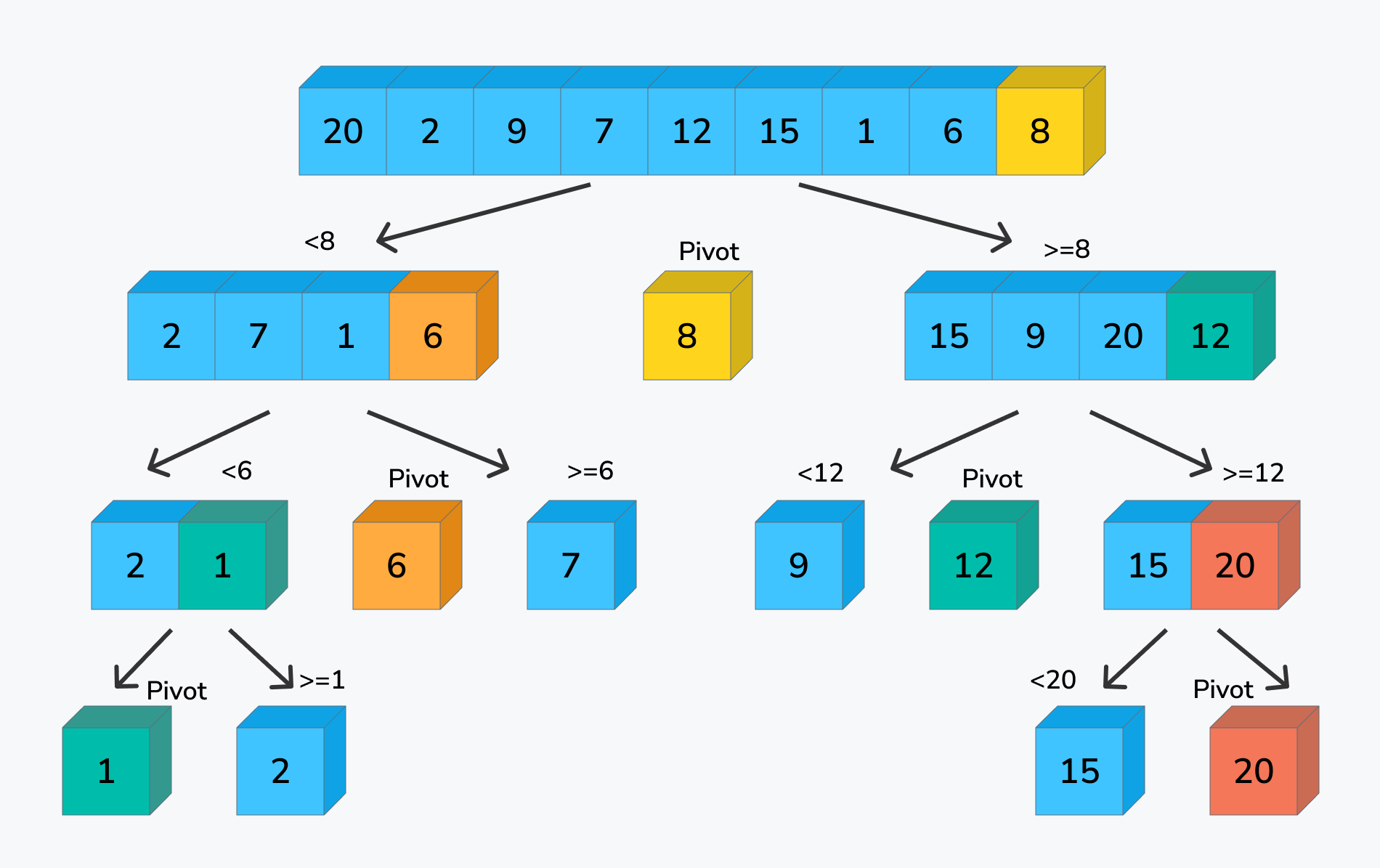Quick Sort Algorithm
 Avdhesh Varshney
Avdhesh Varshney
Quick sort is a widely used sorting algorithm that follows the divide-and-conquer strategy. It selects a pivot element, partitions the array around the pivot, and recursively sorts the subarrays, resulting in an efficient and in-place sorting method.
In general, when we talk about sorting, it means we talk about arranging elements in increasing order.
Method
First of all, The Requirement is the choice of the pivot point.
We can choose any element as a pivot element like,
First element
Middle element
Last element
or maybe any random element
This pivot point is required in this algorithm because recursively, the array will sort about this point only.
Implementation of Quick Sort program
Create a recursive function, say
quicksort(), this recursion function will call thepartition()function recursively until the array has not been sorted.This function will again call the
quicksort()function to sort the left half array and right half array until the left pointer does not exceed the right pointer.These
lowandhighpointers signify the range of the array required to be sorted.On every call, first of all, it will check that the
lowshould be less than thehighpointer.Now, let's talk about the partition, This partition is done about the pivot point as mentioned earlier. Then, two recursion calls are takes place after partition, one for the left part and another for the right part about the pivot point.
It means, first in the stack left most of the array will sort first, then on returning to the right part of the array the pivot point will go for sort.
Hence, on the wrap of the recursion calls, sorting will be done.
Implementation of the Partition program
The partition function will take, a full array, say
arr, lowest point, saylow, and highest point, sayhighas the input.This array will take by reference as input as sorting is directly done by the input array.
Inside the program of
partition(), it is required to choose a pivot point according to your convenience, here right-most points will be considered as the pivot point.After choosing the pivot point, let's start from the leftmost element and keep track of the index of the smaller or equal elements, here say
low-1, about the pivot point and swapping the current element, here sayarr[j], with the smaller element. Otherwise, ignore the swapping operation and move to the next indexed element.At the end swap the last smaller element, say
arr[i + 1]with the highest element, sayarr[high]and return the index of the smaller element, herei+1.
Code
Example

C++
#include <bits/stdc++.h>
using namespace std;
int makePartition(vector<int>& arr, int low, int high) {
int pivot = arr[high];
int i = (low - 1);
for (int j = low; j <= high - 1; j++) {
if (arr[j] < pivot) {
i++;
swap(arr[i], arr[j]);
}
}
swap(arr[i + 1], arr[high]);
return (i + 1);
}
void quickSort(vector<int>& arr, int low, int high) {
if (low < high) {
int pi = makePartition(arr, low, high);
quickSort(arr, low, pi - 1);
quickSort(arr, pi + 1, high);
}
}
int main() {
vector<int> arr = {20, 2, 9, 7, 12, 15, 1, 6, 8};
int n = arr.size();
quickSort(arr, 0, n - 1); // Sorting is done recursiverly
cout << "Sorted array: " << endl;
for (int i = 0; i < N; i++)
cout << arr[i] << " ";
cout << endl;
return 0;
}
Python
def makePartition(arr, low, high):
pivot = arr[high]
i = low - 1
for j in range(low, high):
if arr[j] <= pivot:
i = i + 1
(arr[i], arr[j]) = (arr[j], arr[i])
(arr[i + 1], arr[high]) = (arr[high], arr[i + 1])
return i + 1
def quicksort(arr, low, high):
if low < high:
pi = makePartition(arr, low, high)
quicksort(arr, low, pi - 1)
quicksort(arr, pi + 1, high)
if __name__ == '__main__':
arr = [20, 2, 9, 7, 12, 15, 1, 6, 8]
n = len(arr)
quicksort(arr, 0, n - 1)
print('Sorted array:')
for x in arr:
print(x, end=" ")
print("\n")
Complexity Analysis
Time Complexity:
Best Case: O( n log(n) )
Average Case: O( n log(n) )
Worst Case: O( n^2 )
Space Complexity:
O ( n ) // This is due to recursion calls in the stack
Precautions while selecting the pivot point
Randomization: This will remove the chances of the worst-case scenarios.
Median of Three: Instead of choosing the last element as a pivot point, It is advisable to take the median of the first, middle, and last element of the array as the pivot point of the array. This will reduce the risk of choosing extreme values.
Avoiding sorted and nearly sorted arrays: Quick sort algorithm will degrade the program's efficiency.
Select the pivot point in such a way as to handle the duplicate values in the arrays. Techniques like the "Dutch National Flag" algorithm or "Hoare's Partition Scheme" can be employed to handle duplicate values more efficiently.
Subscribe to my newsletter
Read articles from Avdhesh Varshney directly inside your inbox. Subscribe to the newsletter, and don't miss out.
Written by

Avdhesh Varshney
Avdhesh Varshney
I am an aspiring data scientist. Currently, I'm pursuing B.Tech from Dr. B R Ambedkar NIT Jalandhar. Contributed a lot in many open-source programs and secured top ranks amongs them.